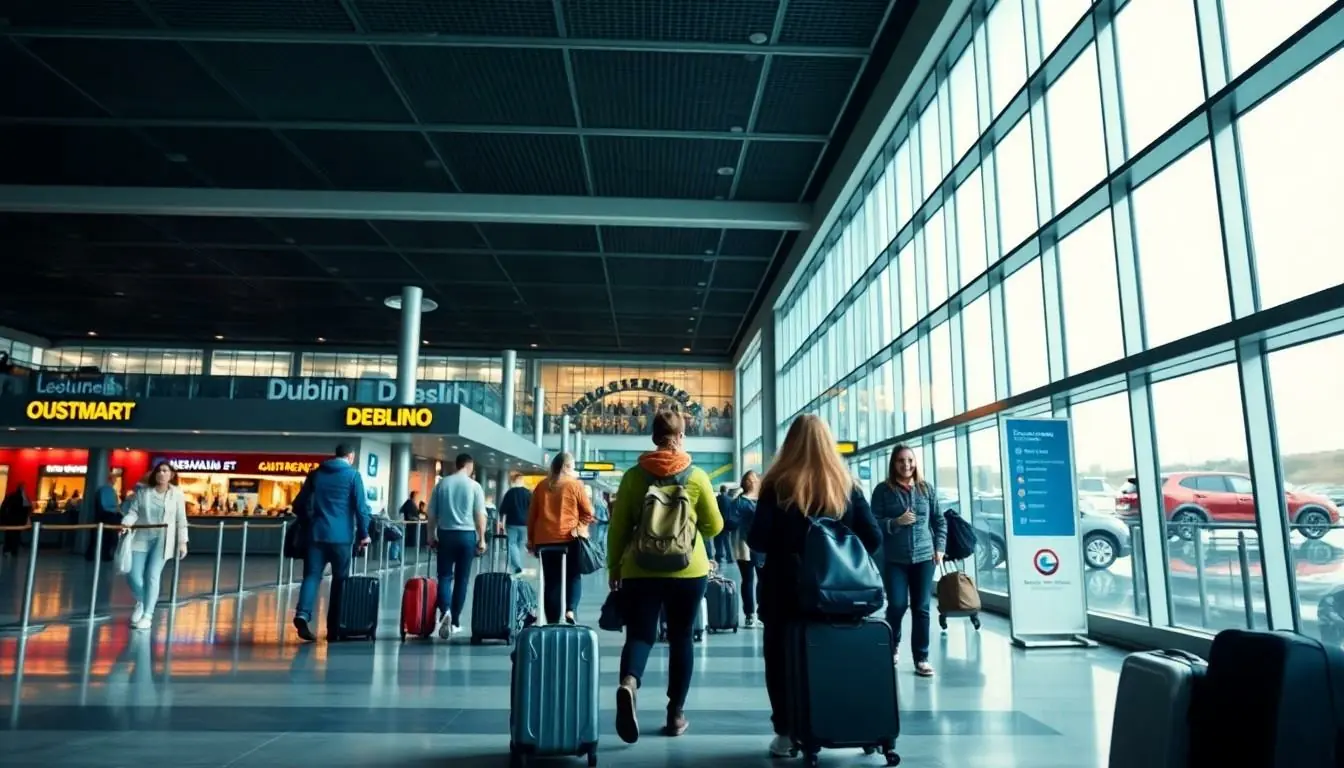Dublin, the city where history and mischief collide, beckons travelers with its charming streets and vibrant culture. From the moment one steps into this lively capital, it’s hard not to fall under its spell. Whether it’s the intoxicating aroma of fresh-baked soda bread or the lively tunes spilling from a local pub, Dublin has a way of making every visitor feel right at home.
Table of Contents
ToggleOverview of Dublin
Dublin stands as Ireland’s bustling capital, known for its rich heritage and dynamic energy. Historic landmarks like Dublin Castle and St. Patrick’s Cathedral showcase the city’s deep-rooted history. Visitors often wander through the cobbled streets of Temple Bar, famous for its vibrant nightlife and artistic spirit.
Culture thrives in Dublin, evident in its numerous museums, galleries, and theaters. The National Museum of Ireland offers insights into the nation’s history, while the Abbey Theatre highlights the city’s theatrical talent. Visitors engage with art and performances that reflect Dublin’s creativity and passion.
Food plays a significant role in Dublin’s charm. Local eateries serve traditional Irish dishes alongside modern cuisine, appealing to diverse tastes. Iconic foods like Irish stew and soda bread are must-tries for anyone exploring the city.
Transport options in Dublin are varied and convenient. The Luas tram system provides an efficient way to navigate the city’s attractions. Buses and taxis are readily available, making the city accessible for all visitors.
Weather in Dublin tends to be mild and changeable. Packing an umbrella is advisable as rain can occur throughout the year. Spring and early autumn offer pleasant temperatures, making these seasons popular for travel.
Dublin’s friendly atmosphere encourages social interaction. Locals are known for their hospitality, making newcomers feel at home quickly. Engaging in conversations with residents often leads to discovering hidden gems and unique experiences.
Getting There

Reaching Dublin offers various options, making travel convenient. Multiple transportation avenues connect visitors to this vibrant city.
Airports
Dublin Airport serves as the primary international gateway. Located about 10 kilometers north of the city center, the airport hosts flights from numerous global destinations. Terminal 1 primarily accommodates short-haul flights, while Terminal 2 caters to long-haul services. Passengers often find several amenities, including shops, dining, and car rental services. Travelers often choose taxis or buses for quick access to the city upon arrival.
Train and Bus Options
Public transport options include trains and buses, catering to various needs. The Luas tram system efficiently connects neighborhoods and the city center, featuring two main lines: the Red Line and the Green Line. Bus services operate frequently, connecting major attractions. Dublin Bus provides routes throughout the city and suburbs, ensuring easy access for visitors. Intercity buses connect Dublin with other Irish cities such as Cork and Galway, offering additional travel flexibility.
Best Time to Visit Dublin
Dublin experiences a temperate maritime climate, making it a year-round destination. The best time for visitors is from March to May and September to October. Spring brings blooming flowers and mild temperatures, creating a scenic backdrop for city explorations. During this period, average temperatures range from 45°F to 60°F, with occasional rain.
Fall offers comfortable weather and fewer crowds, making it a great choice for travelers wanting to explore attractions without the hustle. Rain does happen throughout the year, so carrying an umbrella proves handy regardless of the season.
Summer, from June to August, attracts numerous tourists with temperatures reaching up to 70°F. Events and festivals fill the calendar, including the Bloomsday celebration in June, which pays tribute to James Joyce.
Winter months, December through February, see fewer tourists. While temperatures drop to about 35°F to 50°F, visitors can enjoy the city’s festive atmosphere during the holiday season. Christmas markets and local celebrations add charm during this time.
For budget-conscious travelers, visiting during the rainy months of November and January can provide lower accommodation prices. Each season offers unique experiences, allowing visitors to choose what suits their interests best.
Must-See Attractions
Dublin boasts a range of attractions that capture its rich history and vibrant culture. Travelers find plenty to explore throughout the city, from historic structures to artistic venues.
Historical Sites
Dublin Castle, dating back to the 13th century, offers a glimpse into the city’s storied past. Visitors can enjoy guided tours that reveal its transformation over the centuries. St. Patrick’s Cathedral stands nearby, recognized as the largest cathedral in Ireland, featuring stunning architecture and beautiful grounds. Kilmainham Gaol, a former prison, tells tales of pivotal moments in Irish history, making it a powerful site for reflection. The General Post Office, known for its role during the Easter Rising, highlights the city’s fight for independence and is an iconic symbol of Dublin.
Cultural Landmarks
The Abbey Theatre represents a cornerstone of Irish drama and is vital to Dublin’s cultural scene. Patrons can catch performances highlighting Irish stories and traditions. The National Museum of Ireland features extensive collections showcasing the nation’s heritage through art, archaeology, and natural history. Another must-visit is the Trinity College Library, home to the Book of Kells, an exquisite manuscript revered for its artistic beauty. The hauntingly beautiful Dublin Writers Museum celebrates the city’s literary achievements and honors esteemed authors such as James Joyce and W.B. Yeats. Each landmark offers unique insights that enrich any visit to Dublin.
Local Cuisine
Dublin’s local cuisine showcases scrumptious flavors and traditional dishes that reflect its rich heritage. Visitors can indulge in hearty meals and local beverages that embody the spirit of the city.
Traditional Dishes
Irish stew, made with lamb or beef, potatoes, carrots, and onions, stands as a beloved staple in Dublin. Soda bread, often served warm with butter, accompanies many meals and offers a delicious taste of Irish baking. Colcannon, consisting of mashed potatoes mixed with cabbage or kale, provides a traditional side dish that complements various entrees. Seafood chowder features fresh fish and cream, embracing the coastal influence on Dublin’s culinary scene. Additionally, the full Irish breakfast—consisting of eggs, sausages, bacon, black and white pudding, and baked beans—offers a hearty start to the day for travelers exploring the city.
Recommended Restaurants
Several restaurants excel in serving Dublin’s traditional cuisine. The Woollen Mills, a popular eatery, emphasizes local ingredients and classic dishes, with a lively atmosphere and creative flair. For finer dining, Chapter One provides a Michelin-starred experience, blending modern and traditional flavors with seasonal menus. O’Neill’s Pub showcases a range of Irish classics in a cozy setting, perfect for enjoying hearty meals and a pint of Guinness. Gallagher’s Boxty House specializes in boxty, potato pancakes filled with various meats or vegetables, revealing an authentic taste of Irish comfort food. Lastly, The Exchequer stands out with its contemporary take on traditional dishes, offering visitors a unique dining experience that celebrates Dublin’s culinary heritage.
Accommodation Options
Dublin offers a variety of accommodation options to suit all preferences and budgets.
Budget Hotels
Budget hotels provide affordable yet comfortable lodging for travelers. Properties like The Abbey Court Hostel and The Samuel Henry’s Hotel blend convenience and cost-effectiveness. These accommodations often feature shared dormitories or private rooms, catering to backpackers and families alike. Many budget hotels are located near public transport, allowing easy access to attractions. Locations in the city center make exploring local sights hassle-free. Competitive pricing and essential amenities ensure visitors enjoy a pleasant stay without overspending. Loyal guests often return for the friendly atmosphere and helpful staff.
Luxury Stays
Luxury stays in Dublin offer an upscale experience with exceptional service. Hotels like The Shelbourne and The Fitzwilliam display elegance and charm in prime locations. Guests revel in lavish rooms, fine dining options, and spa treatments. Many luxury hotels boast stunning views of the River Liffey or historic landmarks. High-end amenities include fitness centers, personalized concierge services, and exquisite decor. With a focus on comfort and exclusivity, these stays provide an unforgettable experience for discerning travelers. Fine attention to detail ensures each guest feels pampered throughout their visit.
Tips for Navigating the City
Navigating Dublin proves effortless with various transport options and pedestrian-friendly streets.
Public Transport
Dublin’s public transport system includes the Luas tram, which connects neighborhoods and key attractions efficiently. Buses provide extensive coverage, offering routes throughout the city for quick travel. Taxis and ride-sharing services also operate widely, ensuring convenience for travelers. A Leap Card allows easy access to both the Luas and bus services, providing further savings. Dublin’s transport network functions well, making it simple to explore popular spots like Temple Bar and St. Stephen’s Green.
Walking Tours
Walking tours constitute an excellent way to experience Dublin’s rich history and vibrant culture firsthand. Tour guides lead visitors through cobbled streets, providing insights into the city’s landmarks and hidden gems. Each tour highlights significant sites like Dublin Castle, the General Post Office, and Trinity College, enhancing the overall experience. Flexible pacing allows participants to absorb the atmosphere fully. Exploring on foot reveals delightful cafés and unique shops, capturing the essence of Dublin’s charm.
Dublin’s allure lies in its perfect blend of history and modern vibrancy. The city’s welcoming atmosphere and rich cultural offerings make it an unforgettable destination. From the lively streets of Temple Bar to the serene beauty of historic landmarks, every corner of Dublin tells a story.
Travelers will find a diverse culinary scene that reflects the heart of Irish hospitality. With various transport options and a friendly local community, exploring this captivating city is both easy and enjoyable. Whether visiting during the lively summer months or the festive winter season, Dublin promises experiences that resonate long after the trip is over. Embrace the adventure and let Dublin’s charm unfold.





